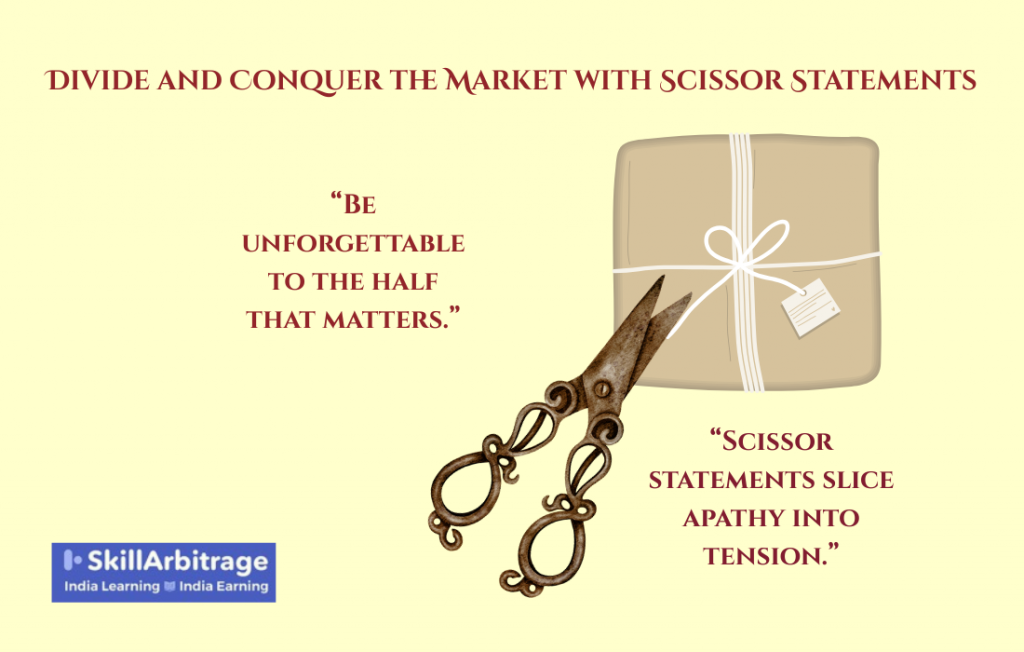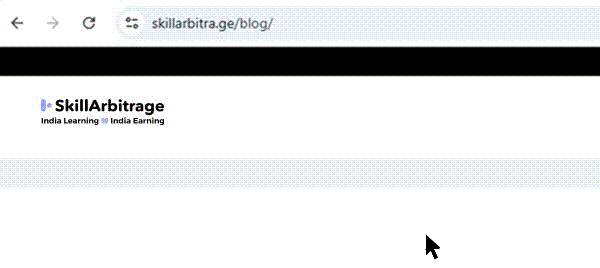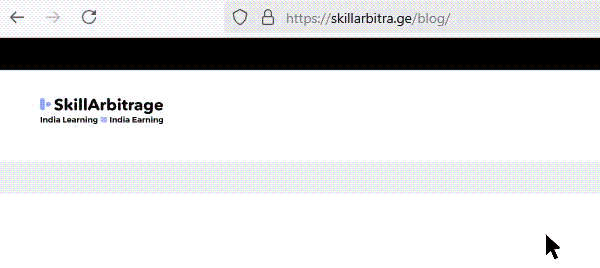“Scissor statements can carve out a bold, distinct position for your clients, setting them apart from the crowd. This article is for Indian freelancers who want to break into high-value brand consulting with a bang. You will learn why most brands blend in and how you can use scissor statements to ensure your clients stand out.”
Table of Contents
Previously on Beginner Blueprint…
Raja went on a wild rant during a rooftop date. Part rebellion, part revelation. He unloaded everything he’d soaked in from Swathi, Raghunandan, and Parvathishankar.
Savitha, his date, was stunned. She told her boss.
That boss? Yamini Kamat, CEO of Yamini Skinworks.
Now, Raja steps into the perfumed corridors of a luxury skincare brand.
Armed with a box, a metaphor, and the nerve to say what brands fear to admit.
He introduces Yamini to a sharper weapon. Scissor statements.
(Continued…)
Aromas of jasmine-scented toner and fermented green tea drifted through the glass lobby. Sunlight hit chrome. Everything was curated. Airbrushed. Suspiciously silent.
Raja entered, holding a gift box tied with a maroon ribbon and that unmistakable “trying-not-to-sweat” freelancer energy. His shirt was ironed like he cared too much. His sneakers tried to pretend he didn’t.
At the reception desk, Savitha Nair looked up from her screen, raised one eyebrow, and smiled.
“You’re five minutes early,” she said. “You’re not from Bombay, are you?”
“I’m from Kumbakonam,” Raja grinned. “We show up early, bring gifts, and confuse women with metaphors.”
Savitha stood up, amused. “Oh, perfect. Yamini loves confusion.”
She reached for the box.
“Hey… I’m supposed to give it to her directly,” Raja said. “It’s part of the… experience.”
“Oho,” Savitha said, eyebrows dancing. “So this isn’t a gift. It’s a reveal.”
She led him through a hallway lined with minimalist Ayurveda posters, “Balance Is Beauty” and “Return to Ritual,” situated dramatically before a heavy walnut door.
Inside, Yamini Kamat stood by a bookshelf, mid-call. Cool. Impeccable. The kind of woman who made silence feel like a power move.
She ended her call. Savitha swept in like she was introducing the final scene of a play.
“Yamini, this is Raja. Copy consultant, strategist, metaphor machine.
Raja, this is Yamini. CEO. Skincare oracle. Has never taken a bad photo.”
“A pleasure,” Raja said, with quiet confidence.
They shook hands. Yamini gestured toward the seating. Raja offered the box.
“I brought something.”
Yamini smiled, cautious. “You’re full of surprises already.”
She untied the ribbon. Opened the lid.
Inside: a gleaming, oversized pair of scissors. Antique finish. Heavy. Real. A sculptural object and a statement.
There was a pause.
“Well,” Savitha said in a deadpan voice. “Either he’s cutting the marketing budget or he’s about to say something madly profound.”
“He is… dramatic,” Savitha said, giving Yamini the I-told-you-so look.
Raja nodded. “It had to be. I’ve been studying Yamini Skinworks.”
Savitha tilted her head, smirking. Yamini blinked, caught off guard.
“I know your customers. I know your category. And I know what your brand’s too polite to admit.”
I. Recognizing troubled brands in crowded categories
He held her gaze.
“You speak like a luxury label. But you price like you’re scared. One week it’s Ayurvedic purity. Next, it’s 20% off if I act now. You say you’re premium, but you behave like a brand afraid no one believes it.”
He tapped the box gently, the oversized scissor still catching light.
“That gap. That’s where trust bleeds out. Not because your product isn’t good. Because your story flinches first.”
He leaned forward, the glint of a smile on his face, like someone about to pull off a magic trick.
The box was open. So was the floor.
Now it was time to cut through.
Raja didn’t rush. He let the silence stretch, like a bowstring pulled tight.
Then, with quiet clarity:
“The opposite of love isn’t hate. It’s indifference.”
Yamini smiled faintly. Savitha tilted her head, mock-thoughtful.
“So what you’re saying is… people don’t hate the brand. They just don’t care?”
Raja nodded. “Exactly. And in your category, that’s the death sentence. Natural skincare isn’t a market anymore. It’s a buffet. And no one’s hungry.”
He paused, then gestured gently to Yamini’s own product display on the wall.
“Everyone’s promising clean, safe, inclusive. Everyone’s whispering in lowercase. Everyone’s being nice. And in trying to offend no one, most brands say nothing.”
Yamini leaned back slightly, her brow tightening in thought.
“But we have to be inclusive. That’s part of who we are.”
“Absolutely,” Raja said. “But let me ask you this. If your values are the same as your competitors… if your tone is the same… if your packaging is the same beige and eucalyptus as everyone else…”
He tapped the scissor.
“Why should anyone feel anything about you?”
Savitha let out a low whistle. “Oof. That cut.”
Raja smiled. “In a saturated market, your real enemy isn’t another brand. It’s apathy. And you don’t fight apathy with agreement. You fight it with tension.”
He looked straight at Yamini.
Freelancer tip
If a brand looks premium but keeps giving discounts, something’s not working. That’s your way in.
II. What is a scissor statement?
Yamini didn’t blink.
“Conflict? Like outrage marketing?”
Raja shook his head. “Not cheap provocation. I’m talking about precision. A tool. Not a tantrum.”
He lifted the scissor from the box, holding it delicately by the hinge.
“Have you heard of a scissor statement?”
Savitha gave a mock gasp. “Wait. This is a metaphor? I thought we were cutting ribbon.”
Raja smiled, then turned back to Yamini.
“The term comes from a writer named Scott Alexander. He described scissor statements as lines so emotionally charged that they split even people with shared facts into opposing camps. Not just disagreement. Identity war.”
He clicked the scissor once. Sharp and final.
“In marketing, we sharpen it further. A scissor statement isn’t about opinions. It slices your audience into two selves. One group feels proud to be on your side. The other feels accused. Called out. Neither can scroll past you.”
Yamini folded her arms, eyes narrowing slightly, the kind of look that meant she was fully listening.
“So you want us to alienate half our customers?”
“No,” said Raja. “I want you to become unforgettable to the half that matters.”
He laid the scissor gently on the table. The metal caught the light.
“You’re not selling to everyone. You’re selling to the ones who see themselves in your mirror. But they won’t see themselves if you don’t draw a line.”
Freelancer tip
A scissor statement isn’t just a line that sparks debate. It’s a line that forces people to take sides.
III. Why scissor statements work
Yamini reached for the scissor, tracing the smooth arc of its handle with her thumb.
“Let’s say I believe you,” she said. “Why does this… actually work?”
Raja didn’t rush the answer.
“In bloated markets, clarity is rebellion.”
He let the words settle.
“Everyone’s trying to say the same safe thing in slightly different ways. Moisturizing. Nourishing. Clean. Gentle. But the customer doesn’t feel tension. They feel nothing.”
He tapped the table softly, once.
“A scissor statement slices through the noise. It compresses the chaos into a binary. It’s not just another option. It’s a question. Which side are you on?”
Savitha arched an eyebrow. “Bit intense for skincare, no?”
Raja grinned. “Skincare is personal. It’s not just lotion. It’s self-trust. Vanity. Control. You’re not selling function. You’re selling a feeling of who they are when they use your product.”
Yamini tilted her head. “So the scissor cuts deeper than the skin.”
“Exactly,” Raja said. “People don’t fight over opinions. They fight over identity. A good scissor statement doesn’t just say something true. It says something about you. It becomes a mirror or a threat. But never neutral.”
Savitha sipped her coffee and muttered, “God, this man’s pitching total war.”
Raja ignored her. “And once that tension hits, it sticks. Belonging or backlash. Either way, they remember your brand. You stop being background. You start being the brand they talk about, argue over, believe in, or walk away from.”
Yamini looked down at the scissor again.
“Alright,” she said. “So what would it look like for us?”
Freelancer tip
If you know how to write copy that says, “This is for you,” now level up by writing copy that also says, “This is not for them.”
IV. How to know if your client is ready for a scissor statement
Raja reached into his bag again, this time pulling out a folded sheet.
“I call it the Scissor Strike Scorecard.”
Yamini raised an eyebrow. “You brought homework?”
Savitha leaned in. “Tell me you laminated it.”
“No,” Raja deadpanned. “But I probably should.”
He slid the paper toward Yamini.
“Seven questions. Answer honestly. It’ll tell you whether your brand is ripe for a scissor—or if you’re trying to start a knife fight in a nursery.”
Yamini skimmed the list:
1. Is your category overcrowded?
She nodded.
2. Do all your competitors sound the same?
Another nod.
3. Are product differences almost invisible to customers?
“Unfortunately, yes,” she murmured.
4. Is there no emotional leader in the space?
She looked up. “Not really. It’s all muted empowerment and muted earth tones.”
5. Are you frustrated but hesitant to push too hard?
She hesitated. Then gave a slow, guilty smile. “That’s… alarmingly accurate.”
6. Are there unspoken tensions or dueling belief systems under the surface?
“Traditional Ayurveda vs modern science. All the time.”
7. Do customers switch brands often? No loyalty?”
She sighed. “Yes. It’s a revolving door.”
Raja sat back, arms crossed, like a magician waiting for applause.
“That’s a six out of seven. Which means you don’t need another moodboard. You need a war cry.”
Savitha grinned. “A scissor strategy, eh?”
“No,” Raja said, eyes on Yamini. “A scissor strike.”
Freelancer tip
If your client’s category is overcrowded, their competitors sound the same, and loyalty is non-existent, it’s time for a scissor statement to cut through the noise and create a clear brand identity.
V. Example in natural skincare
Yamini was quiet. Not the awkward kind. The kind that comes before a spark.
Raja leaned forward. Not to break the silence, but to aim it.
“In natural skincare, the war isn’t on your shelf. It’s in the buyer’s mind.”
He paused, let that breathe.
Then he said it.
“There are two kinds of women:
Those who know what their skin needs.
And those who let beauty brands decide for them.”
Yamini blinked.
Savitha let out a low whistle. “Oof. That’s got teeth.”
Raja nodded. “It cuts clean. That’s the point.”
He turned back to Yamini.
“Right now, your customer is swimming in oatmeal-colored kindness. Everyone’s gentle. Everyone’s inclusive. No one takes a stand. But this…”
He tapped the air where the line hung invisible.
“This splits the market into intuitive rebels and obedient followers. You stop selling botanical extracts. You start selling sovereignty.”
Yamini looked back at the gift box. The scissor gleamed like it agreed.
“You don’t sell a cleanser,” Raja said softly.
“You sell conviction.”
Freelancer tip
In a crowded market, don’t just sell a product. Use a scissor statement to clearly show who your brand is for and who it’s not for. This helps your message stand out and attract the right people.
VI. How to craft a scissor statement
Yamini was scribbling something in a corner of her notebook. She didn’t look up.
Raja continued.
“Look, these don’t fall from the sky. You don’t ‘come up with’ a scissor statement. You sharpen it.”
He raised three fingers.
“First, you find the hidden tension. Not features. Not benefits. The secret war. The thing no one says, but everyone feels.”
Savitha tilted her head. “Like… what?”
“Like how most women feel low-key judged for not having a skincare routine. Or how some silently think ‘natural’ means weak. Or how no one wants to admit they don’t know what their own skin actually needs.”
He held eye contact with Yamini.
“What’s the self-image no one dares to poke? That’s your battlefield.”
Second finger.
“Then, you frame it as a binary. Not a clever metaphor. Not a vague allusion. A line in the sand. There are two kinds of people. You either trust your skin or outsource it. You either own your beauty or rent it.”
Third finger.
“Finally, you choose your side. Loudly. You don’t play neutral. You empower one group. You make them feel smart, evolved, awake. And you let the other group squirm.”
He smiled, soft and lethal.
“Because the louder the judgment, the clearer the belonging.”
Freelancer tip
To craft a scissor statement, start by identifying the hidden tension, something your audience feels but no one openly discusses. Then, frame it as a clear choice, showing two opposing sides. Finally, take a strong stand, empower one side, and let the other group feel uncomfortable. This makes your brand distinct and resonates with the right audience.
VII. When to use this strategy (and when not to)
Yamini closed her notebook. Her eyes were on him now. Not just curious but calculating.
Raja nodded, as if he’d been waiting for that.
“But here’s the thing,” he said. “This isn’t a party trick. You don’t throw a scissor statement at every brand and hope something sticks.”
He leaned back, voice steady.
“Use this when the market is bloated. When everyone’s saying the same thing with different fonts. When the brand has respect, respect but no recall.”
He looked at Savitha. She was already mouthing along with him, smirking.
“When the founder is burning inside, but the copy still sounds like it’s trying not to offend a WhatsApp group.”
Yamini laughed. Quiet but real.
“And most of all,” Raja added, “when customers don’t know what to choose anymore. Not because nothing stands out. But because nothing dares to stand out. That’s when you split the room.”
He paused, then held up a finger.
“But don’t use it if the market is still forming. If your audience is still figuring out what they even care about. If the brand hasn’t earned the right to provoke, don’t provoke.”
His voice lowered.
“You need fire. But you also need fuel.”
Freelancer tip
Use a scissor statement when the market feels crowded and brands all sound the same. It’s perfect when customers are confused because nothing stands out. Don’t use it if the market is still new or the brand isn’t ready to make bold moves.
VIII. Strategic outcome: Category collapse
Raja uncrossed his legs, his voice cooling like steel after flame.
“Scissor statements don’t play the game. They end it.”
He pointed at the open box again. The shears glinted under the cafe lights, no longer a gag gift. Now a symbol.
“You don’t try to outshine every other brand. You slice the space in half. You stop being another option. You become the only option for the ones who choose your side.”
Yamini said nothing. But the silence had shifted. It wasn’t doubt. It was weight.
“You don’t need consensus,” Raja said. “You need conversion. And not the shallow kind—the kind that starts in the chest. Belief, not clicks.”
He stood up, slowly, like the meeting had ended before anyone realized.
“Don’t chase the whole room, Yamini. Just rally your people. Loudly. Clearly. Unapologetically.”
He smiled again, softer this time.
“That’s how you collapse a category. And win by default.”
Freelancer tip
A scissor statement helps you stand out by focusing on one group of people who believe in your message. Don’t try to please everyone. Be clear about who you’re for and who you’re not. This is how you become the only choice for the right customers.
As Raja walked out, Savitha stayed behind. Still leaning on the doorframe. But her eyes followed with something resembling admiration.
Yamini hadn’t moved.
The scissors lay open on the table, mouth agape like they’d just spoken.
Her team would call it risky.
Her agency would call it off-brand.
But her gut?
Her gut was already reaching for the handle.
(To be continued…)







 Allow notifications
Allow notifications
